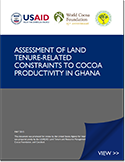The key points emerging from the land use and tenure assessment in Let Maung Kway Village Tract are:
- There is poor infrastructure provision (roads, electricity, irrigation) in all eight villages, but particularly for the northernmost, smaller villages. The villages with the best road access have the opportunity to engage in bamboo ware craft production for the local markets.
- All eight villages have long settlement histories from at least 100 years ago. All villages have ethnically Taungyo residents. Over time, nearly 50% of the more remote, northernmost villages have migrated down to the plains area near Inle Lake in search of water for better agricultural production. In general, there is no significant pattern of seasonal outmigration although some engage in off-season work in Kachin state.
- All land in these villages is on public protected forests under Ministry of Natural Resources and Environmental Conservation’s (MONREC) jurisdiction. The cultivated land is all taungya land with no paddy lands being cultivated. Hence, this is a rain fed agricultural system with no supplementary water supply. The primary crops are upland rice, ginger, pigeon peas, and canola. A range of vegetables and fruits are grown on taungya land as well as on home garden lands. The crops are sold in local markets.
- Villagers are clear, based on mutual understanding, about the boundary demarcations of their villages and household plots. They were not very clear about the village tract boundary. There are no significant conflicts between villagers over taungya land boundaries, or between villages.
- There is a low level of landlessness among all eight villages (less than ten percent). Most landless families were able to create their own land by clearing forests in earlier times.
- There appears to be a process of de-gazettement that was commenced about five months ago by Department of Agricultural Land Management and Statistics (DoALMS) together with MONREC. They came to document the land situation and record cropping arrangements. Only those villages in C group of the village tract (smaller than 50 households) have yet to receive a visit from DoALMS.
- The land market is not active – the area is presently not of interest to buyers. However, given the development of the tourist economy around Inle Lake and the beautiful valley views afforded from some of these villages, it is only a matter of time before the land market starts to gather steam. At present, some villages (the C group) have some excess land which outsiders use, some for a rental fee.
- There is a very low level of awareness and knowledge pertaining to land and forest rights. As such, most villagers were unaware of the existence of the 2012 Farmland Law, 2012 Vacant, Virgin, and Vacant Lands Management Law, the 2012 Association Law, or the draft National Land Use Policy.
- All villages have community forestry areas (20-60 acres). Most were formed under agreement (30-year certificates) with MONREC; some, in the smaller, distant villages, were formed by independent organizations. These areas are used primarily for fuelwood supply. The main purpose of these community forestry areas is to support overall improvement in forest cover and condition in the Inle Lake catchment as a result of the substantial siltation problem it faces.
- Presently, each household makes its own cropping decisions; there is no coordination by village leaders or any land use planning committee. There has been no experience with land use planning in any villages or among the government agencies.


